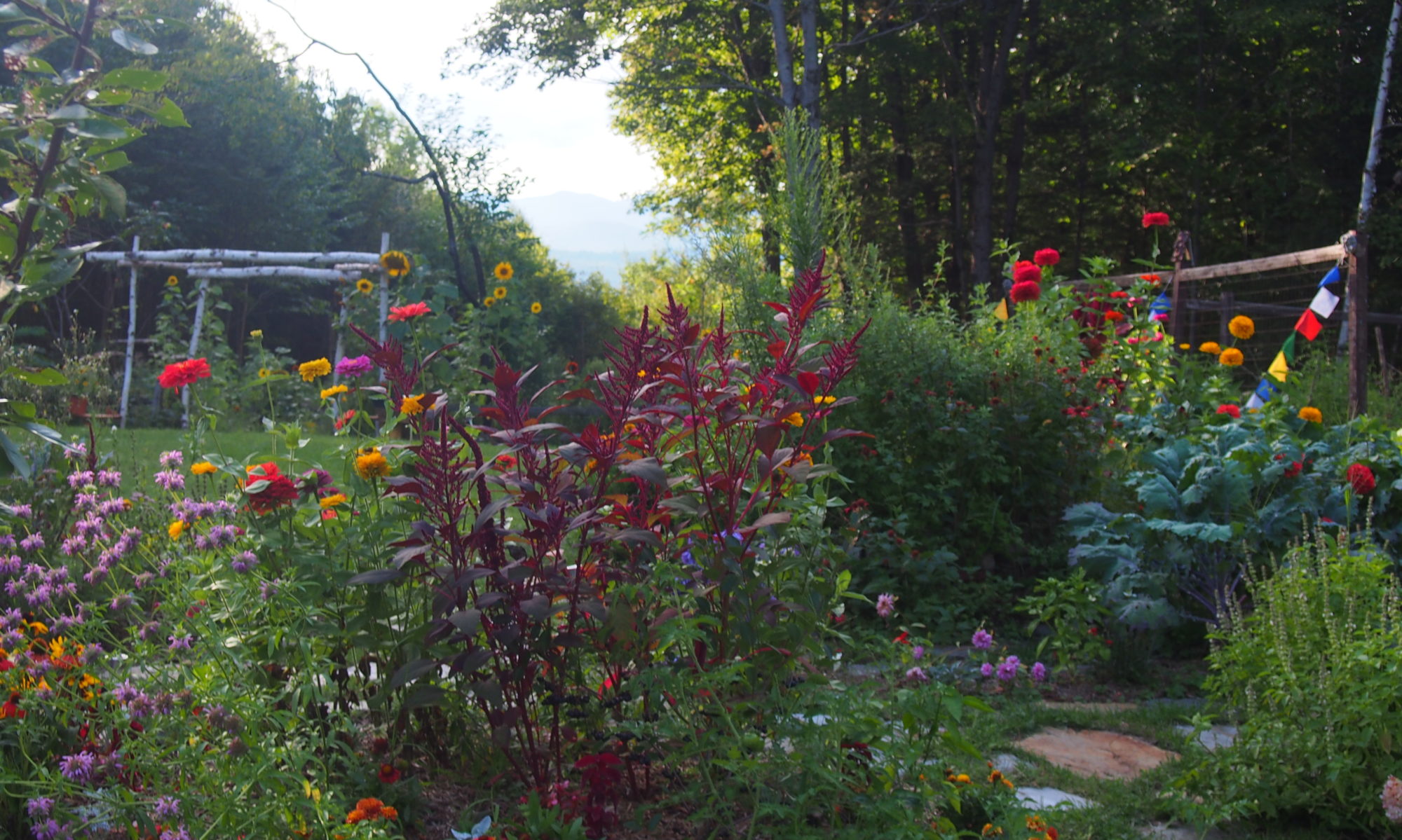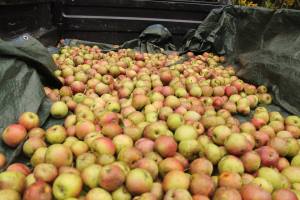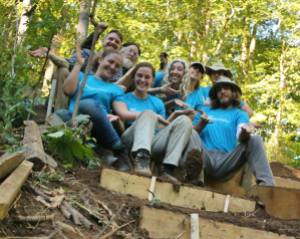Surveying and Managing Non-Native Invasive Plants in Southern Appalachia
By: Stephen Knutson
“You’ve heard of Kudzu, right?”
This was our token response for interested campers at Davidson River Campground, where our crew of three Corps Masters and one experienced supervisor (Lauren Reker of Mountain True, an Asheville-based non-profit focused on positively impacting our region’s ecological contition) were charged with surverying the non-native invasive plant content of an expansive 150-acre piece of property nestled in the Pisgah National Forest in Western North Carolina’s Blue Ridge Mountains. We would then go on to explain that no Kudzu exists in our current survey area, but the plants we are interested in have the same propensity to spread like wildfire if left unmanaged, depriving our native community of the sunlight and soil nutrients that are so vital to a heathy forest. Plants like Multiflora Rose, Japanese Honeysuckle, and Oriental Bittersweet can climb into the sub-canopy and even the canopy layer, raining down seeds and quickly expanding their territory. Invasive trees and shrubs, like Chineese Privet, Autumn Olive, and Japanese Barberry are heavy seed producers who can easily form monocultures, outcompeting crutial native flora in the process.
“You’re surveying the entire campground?”
Campers were often amazed that a team of four individuals could accurately and efficiently collect the data required to sufficiently inform future management initiatives on the Davidson River property, especially considering the size of our survey area and the duration of our project, which was about eighteen total workdays. Surveying was slow going at first, as Katie and I had no prior experience identifying non-native invasives. However, thanks to Lauren’s breadth of knowledge and Nathan’s prior experience in the field, we were able to catch on quickly and were soon covering huge tracts of campground and forest every day. Our team used GIS software to delineate polygons (never more than an acre in area) based mainly on natural borders and existing landmarks within the campground. Once we were all clear on the spacial extent of a particular polygon, we would divide and conquer, with each team member surveying the percent coverage, age class, stem density, stratification, and seed presence of a select number of our target species. We would then reconvene, compare notes, and set out to reconnoiter the margins of our next survey area. This process allowed us to be incredibly efficient in our data collection and resulted in the timely competion of all objectives associated with the Davidson River Campground project.
“My favorite part of the biome.”

As far as physically managing non-native invasives goes, an ecologist has many options to choose from, and that choice is influenced by factors such as effectiveness of treatment and collateral damage to the surrounding native community. One of the most effective strategies with the lowest chance of causing unintended harm to surrounding flora is known as cut-stump application. This process involves cutting a woody-stemmed target as close to its base as possible and subsequently dobbing both stem and stump with a 50/50 concentration of herbicide. It also creates copious amounts of biomass, which must be removed from sensitive areas and properly disposed of. Cut-stump can also be effective without the use of herbicide, which is necessary when working in close proximity to rare and endangered species like Bunched Arrowhead and Pitcher Plants.
“Ghostbusters from planet Eastwood.”

Another management tactic our crew became intimately familiar with this season is foliar application, or the process of applying herbicide directly to the leaves of target species via backpack sprayers. While this strategy is very efficient timewise, minimizing collateral damage becomes much more of a priority, and spraying is therefore reserved for significant inholdings of invasives located a sizeable distance from any rare or endangered species. Other management practices include string-trimming and hand-pulling, both of which are mainly reserved for non-native grasses, such as Microstegium, or Japanese Stilt Grass.
“So, how do you manage Kudzu?”

What most people don’t know about Kudzu is that the leaves are edible, with a similar flavor and texture to collard greens. While we as humans are a long way from incorporating this invader into our daily diets, Jasper and his thirteen hooved and horned counterparts subsist almost exclusively through the herbivorization of Kudzu. And they don’t just eat the leaves. These bad boys cause significant stem damage, hitting the plant where it hurts, and truly making an impact on their project sites. A herd of fourteen goats can typically devour an acre of Kudzu in around three weeks’ time, making applied herbivory one of the most effective and ecologically sound management strategies for dealing with the vine that ate the south.
“What’s the Point?”

Many campers at Davidson River would ask us, “What’s the point? Why not let nature take its course?” It’s here that the word, “Conservation” comes to mind. We do this work in order to maintain and revitalize our native plant community, one that is nearly unrivaled in its level of diversity. We do this work to provide conditions in which rare species can not only live, but thrive, and we do this work to preserve the natural ecosystem of the Southern Apps that draws so many folks to this beautiful region every year. We do this work because we love and value the natural world, and we take pride in it because we know we’ve made a difference, a positive impact, in the place that we call home. And, to anyone involved in conservation, food access, animal rescue, or any other form of relief work, I, and every soul you touch with your selfless actions, truly do appreciate all of your hard work and dedication.
“That’s all, folks!”




 several steps in that direction. Half of this year’s program focuses on continuing to develop food access and food security projects in the communities of Western North Carolina, and that commitment is reflected at the homestead.
several steps in that direction. Half of this year’s program focuses on continuing to develop food access and food security projects in the communities of Western North Carolina, and that commitment is reflected at the homestead.
 as just picked off the plant minutes before versus trucked for days across country. It just has so much more nutrition and energy in it. Sometimes we get more produce than we can eat in a short time from our gardens, so Heather has taught us how to can and pickle vegetables, and another fun community day project centered around fermentation so it’s all come together really well. We even got to meet Sandor Katz, the famous fermentation revivalist!
as just picked off the plant minutes before versus trucked for days across country. It just has so much more nutrition and energy in it. Sometimes we get more produce than we can eat in a short time from our gardens, so Heather has taught us how to can and pickle vegetables, and another fun community day project centered around fermentation so it’s all come together really well. We even got to meet Sandor Katz, the famous fermentation revivalist! barter from your local farmer, or through gleaning. We will never need to buy butternut squash or bok choy again!
barter from your local farmer, or through gleaning. We will never need to buy butternut squash or bok choy again!












 there is a warmth and magic to enjoying a meal with others whom you are in community with.
there is a warmth and magic to enjoying a meal with others whom you are in community with.

 find that the conversation topics begin to depart from the norm. You reach down deep into the recesses of your mind and find the weird stuff. Hitch is a unique context in which to get to know someone. It accelerates the process of reciprocity and openness.
find that the conversation topics begin to depart from the norm. You reach down deep into the recesses of your mind and find the weird stuff. Hitch is a unique context in which to get to know someone. It accelerates the process of reciprocity and openness.



























